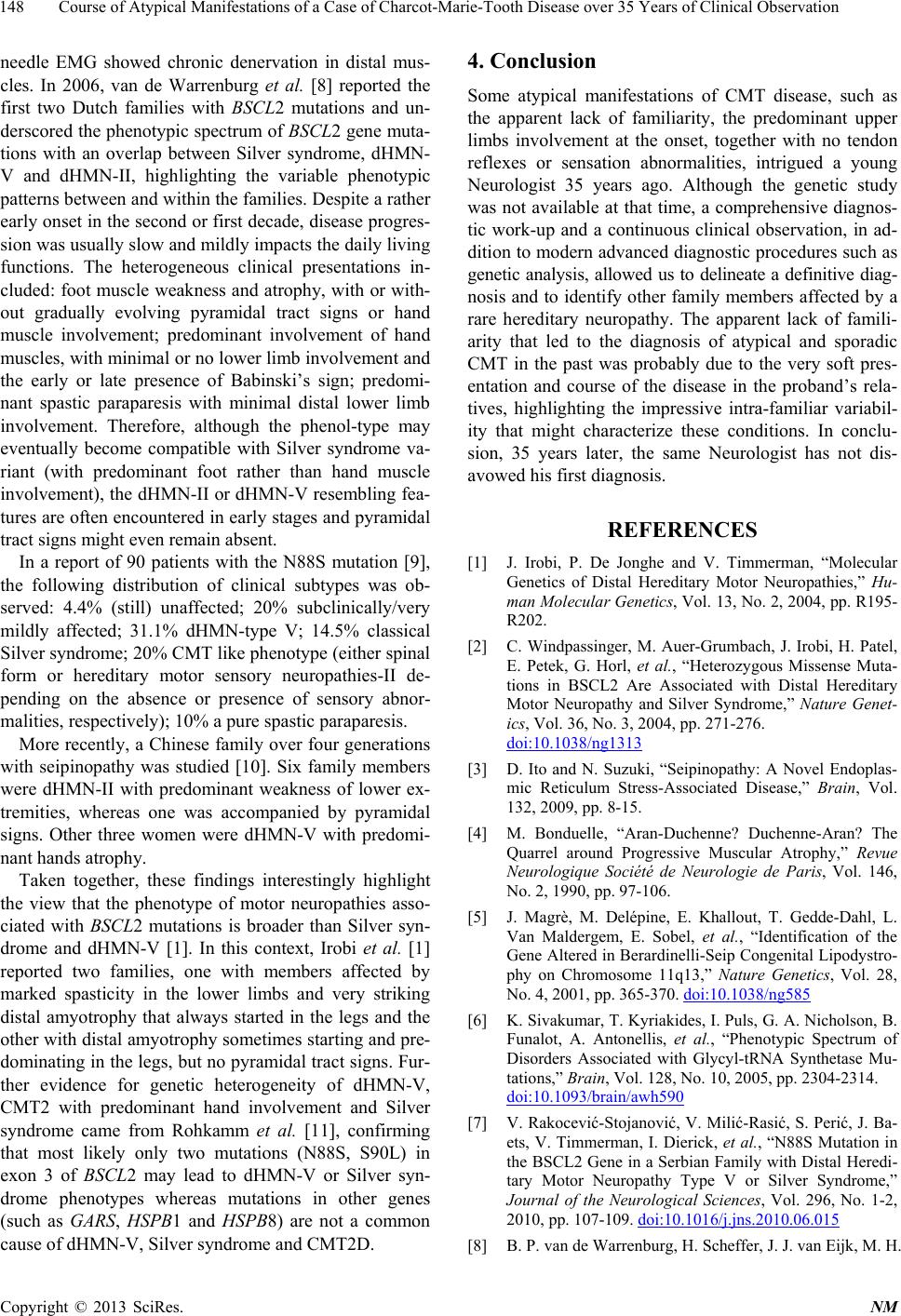
Course of Atypical Manifestations of a Case of Charcot-Marie-Tooth Disease over 35 Years of Clinical Observation
148
needle EMG showed chronic denervation in distal mus-
cles. In 2006, van de Warrenburg et al. [8] reported the
first two Dutch families with BSCL2 mutations and un-
derscored the phenotypic spectrum of BSCL2 gene muta-
tions with an overlap between Silver syndrome, dHMN-
V and dHMN-II, highlighting the variable phenotypic
patterns between and within the families. Despite a rather
early onset in the second or first decade, disease progres-
sion was usually slow and mildly impacts the daily living
functions. The heterogeneous clinical presentations in-
cluded: foot muscle weakness and atrophy, with or with-
out gradually evolving pyramidal tract signs or hand
muscle involvement; predominant involvement of hand
muscles, with minimal or no lower limb involvement and
the early or late presence of Babinski’s sign; predomi-
nant spastic paraparesis with minimal distal lower limb
involvement. Therefore, although the phenol-type may
eventually become compatible with Silver syndrome va-
riant (with predominant foot rather than hand muscle
involvement), the dHMN-II or dHMN-V resembling fea-
tures are often encountered in early stages and pyramidal
tract signs might even remain absent.
In a report of 90 patients with the N88S mutation [9],
the following distribution of clinical subtypes was ob-
served: 4.4% (still) unaffected; 20% subclinically/very
mildly affected; 31.1% dHMN-type V; 14.5% classical
Silver syndrome; 20% CMT like phenotype (either spinal
form or hereditary motor sensory neuropathies-II de-
pending on the absence or presence of sensory abnor-
malities, respectively); 10% a pure spastic paraparesis.
More recently, a Chinese family over four generations
with seipinopathy was studied [10]. Six family members
were dHMN-II with predominant weakness of lower ex-
tremities, whereas one was accompanied by pyramidal
signs. Other three women were dHMN-V with predomi-
nant hands atrophy.
Taken together, these findings interestingly highlight
the view that the phenotype of motor neuropathies asso-
ciated with BSCL2 mutations is broader than Silver syn-
drome and dHMN-V [1]. In this context, Irobi et al. [1]
reported two families, one with members affected by
marked spasticity in the lower limbs and very striking
distal amyotrophy that always started in the legs and the
other with distal amyotrophy sometimes starting and pre-
dominating in the legs, but no pyramidal tract signs. Fur-
ther evidence for genetic heterogeneity of dHMN-V,
CMT2 with predominant hand involvement and Silver
syndrome came from Rohkamm et al. [11], confirming
that most likely only two mutations (N88S, S90L) in
exon 3 of BSCL2 may lead to dHMN-V or Silver syn-
drome phenotypes whereas mutations in other genes
(such as GARS, HSPB1 and HSPB8) are not a common
cause of dHMN-V, Silver syndrome and CMT2D.
4. Conclusion
Some atypical manifestations of CMT disease, such as
the apparent lack of familiarity, the predominant upper
limbs involvement at the onset, together with no tendon
reflexes or sensation abnormalities, intrigued a young
Neurologist 35 years ago. Although the genetic study
was not available at that time, a comprehensive diagnos-
tic work-up and a continuous clinical observation, in ad-
dition to modern advanced diagnostic procedures such as
genetic analysis, allowed us to delineate a definitive diag-
nosis and to identify other family members affected by a
rare hereditary neuropathy. The apparent lack of famili-
arity that led to the diagnosis of atypical and sporadic
CMT in the past was probably due to the very soft pres-
entation and course of the disease in the proband’s rela-
tives, highlighting the impressive intra-familiar variabil-
ity that might characterize these conditions. In conclu-
sion, 35 years later, the same Neurologist has not dis-
avowed his first diagnosis.
REFERENCES
[1] J. Irobi, P. De Jonghe and V. Timmerman, “Molecular
Genetics of Distal Hereditary Motor Neuropathies,” Hu-
man Molecular Genetics, Vol. 13, No. 2, 2004, pp. R195-
R202.
[2] C. Windpassinger, M. Auer-Grumbach, J. Irobi, H. Patel,
E. Petek, G. Horl, et al., “Heterozygous Missense Muta-
tions in BSCL2 Are Associated with Distal Hereditary
Motor Neuropathy and Silver Syndrome,” Nature Genet-
ics, Vol. 36, No. 3, 2004, pp. 271-276.
doi:10.1038/ng1313
[3] D. Ito and N. Suzuki, “Seipinopathy: A Novel Endoplas-
mic Reticulum Stress-Associated Disease,” Brain, Vol.
132, 2009, pp. 8-15.
[4] M. Bonduelle, “Aran-Duchenne? Duchenne-Aran? The
Quarrel around Progressive Muscular Atrophy,” Revue
Neurologique Société de Neurologie de Paris, Vol. 146,
No. 2, 1990, pp. 97-106.
[5] J. Magrè, M. Delépine, E. Khallout, T. Gedde-Dahl, L.
Van Maldergem, E. Sobel, et al., “Identification of the
Gene Altered in Berardinelli-Seip Congenital Lipodystro-
phy on Chromosome 11q13,” Nature Genetics, Vol. 28,
No. 4, 2001, pp. 365-370. doi:10.1038/ng585
[6] K. Sivakumar, T. Kyriakides, I. Puls, G. A. Nicholson, B.
Funalot, A. Antonellis, et al., “Phenotypic Spectrum of
Disorders Associated with Glycyl-tRNA Synthetase Mu-
tations,” Brain, Vol. 128, No. 10, 2005, pp. 2304-2314.
doi:10.1093/brain/awh590
[7] V. Rakocević-Stojanović, V. Milić-Rasić, S. Perić, J. Ba-
ets, V. Timmerman, I. Dierick, et al., “N88S Mutation in
the BSCL2 Gene in a Serbian Family with Distal Heredi-
tary Motor Neuropathy Type V or Silver Syndrome,”
Journal of the Neurological Sciences, Vol. 296, No. 1-2,
2010, pp. 107-109. doi:10.1016/j.jns.2010.06.015
[8] B. P. van de Warrenburg, H. Scheffer, J. J. van Eijk, M. H.
Copyright © 2013 SciRes. NM